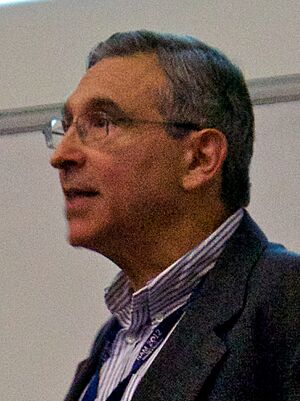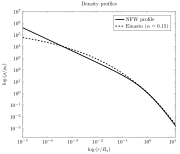Carlos Frenk facts for kids
Quick facts for kids
Carlos Silvestre Frenk
|
|
|---|---|

Frenk in 2012
|
|
| Born | 27 October 1951 |
| Citizenship | British, German and Mexican |
| Alma mater | University of Mexico (BSc) University of Cambridge (PhD) |
| Known for | Navarro–Frenk–White profile |
| Spouse(s) | Dr Susan Frenk |
| Children | 2 |
| Scientific career | |
| Fields | Astrophysics |
| Institutions | Durham University University of Sussex University of California, Santa Barbara University of California, Berkeley |
| Thesis | Globular clusters in the galaxy and in the Large Magellanic Cloud (1981) |
| Doctoral advisor | Bernard J. T. Jones |
| Doctoral students | Ben Moore Gillian Wilson |
Carlos Silvestre Frenk CBE FRS (born 27 October 1951) is a famous Mexican-British cosmologist. Cosmologists are scientists who study the universe and how it began.
Carlos Frenk went to the National Autonomous University of Mexico and the University of Cambridge. He started his research career in the United States. Later, he moved to the United Kingdom for good. In 1986, he joined Durham University. Since 2001, he has been the Ogden Professor of Fundamental Physics there.
Professor Frenk is best known for his work on how galaxies form. He uses big computer simulations to test ideas about how the universe started and changed. With other scientists, he showed that the idea of cold dark matter is likely true. He has written over 500 science articles. Five of his papers are among the most-read in his field. He became a Fellow of the Royal Society in 2004 and has won many awards.
Contents
Early Life and Education
Carlos Frenk was born in Mexico City, Mexico. He is the oldest of six children. His younger brother, Julio Frenk, is an expert in public health. He was even Mexico's Secretary of Health. Carlos's father was a German-Jewish doctor. He moved from Germany to escape persecution before World War II. His mother was a Mexican-Spanish pianist. When he was young, Carlos played basketball semi-professionally. He also loved mathematics.
Frenk first studied engineering at the National Autonomous University of Mexico. Then he switched to theoretical physics. He earned his first degree in 1976. He got the highest grades in his year. He was awarded the Gabino Barreda Medal for this achievement. While visiting Italy, he heard a lecture by Martin Rees. Rees was a professor at the University of Cambridge. Inspired by Rees, Frenk decided to apply to Cambridge. His original plan was to study at Caltech.
That year, he received a British Council Fellowship. He enrolled at the University of Cambridge for advanced math studies. He finished this in 1977. He stayed at Cambridge for his PhD. His supervisor was Bernard J. T. Jones. His research looked at the Milky Way galaxy. At that time, the idea of dark matter was very new. But Frenk concluded that our galaxy was surrounded by this "embedded" dark matter. He earned his PhD in astronomy in 1981.
At Cambridge, Frenk decided to focus on cosmology. He felt there were many "exciting problems" left to solve in this area. He thought particle physics was "moving rather slowly." He met his future colleague, Simon White, at Cambridge. White was already doing research after his PhD. Frenk later called White his "unofficial supervisor."
Career and Research
Early Career: 1981–1986
After Cambridge, Frenk worked as a researcher at the University of California. He arrived at Berkeley in 1981. He was invited by Marc Davis, an astronomer. Davis needed Frenk's background in theoretical physics. He wanted help understanding his research on galaxies. Simon White also moved to Berkeley. This allowed Davis, Frenk, and White to work together. They used computer models to study the early universe.
By the late 1970s, many scientists believed dark matter existed. The neutrino was thought to be a possible candidate. But in 1983, Davis, Frenk, and White published a paper. They showed that dark matter could not be made of neutrinos. Even if neutrinos had enough mass, they would move too fast. They wouldn't be able to clump together to form galaxies.
Frenk left Berkeley for nearby Santa Barbara in 1983. He was also officially linked to the University of Sussex from 1984 to 1985. During these two years, he often traveled between Britain and America. He worked three months in Santa Barbara and three months at the University of Sussex.
The Gang of Four
Using computers to study space was still a new field. Davis, Frenk, and White knew they needed more help. They wanted to create more advanced computer code. George Efstathiou, who had just finished his PhD, joined them. With Efstathiou, the group worked on several important papers. They focused on the idea that dark matter particles were "cold."
In 1985, Frenk and his team published a very important paper. It showed the first computer simulations of cold dark matter. Even with limited computer power, their research got results. Davis, Efstathiou, Frenk, and White became known as the 'Gang of Four'. Their work confirmed that the "cold dark matter theory" was correct. This theory explained how galaxies and other cosmic structures formed. This model is now the main idea in cosmology.
Move to Durham: 1986–2001
In 1986, Frenk became a Lecturer at Durham University. He was recruited by Richard Ellis. Frenk later said the physics department in Durham was "tiny" when he arrived. There was "no theory" and astronomy was "non-existent." With Ellis's help, he worked to improve the department's astronomy research. But he needed powerful computers for his work. After trying to borrow computers, he finally got a MicroVAX model for £40,000. Frenk became a Reader (a senior academic rank) in 1991. He became a full Professor in 1993. During this time, he turned down job offers from the United States and Mexico. One offer would have more than doubled his salary.
While their papers were important, Frenk and White's ideas were not yet widely accepted. Throughout the 1980s and 1990s, they faced criticism. Other scientists supported different dark matter theories. One main alternative was Modified Newtonian dynamics. This was proposed by Israeli physicist Mordehai Milgrom in 1981. However, in 1993, new evidence from the Cosmic Background Explorer supported Frenk and White's ideas.
Research at Durham got a boost in 1994. The High Performance Computing Initiative promised more government resources. By then, White was at the Max Planck Institute for Astrophysics. He and Frenk joined their institutions with other computer astronomers. They formed the Virgo Consortium. This gave Frenk's team access to a supercomputing center in Garching, Germany. It was one of the best facilities in the world.
By the mid-1990s, the cold dark matter model was widely accepted. Scientists then started to study the shapes of dark matter halos.
In 1996 and 1997, Frenk, White, and Julio Navarro published their findings. Navarro was the main author. Their work was based on analyzing halos from cold dark matter simulations. This collaboration created the Navarro-Frenk-White profile. This model describes how dark matter is spread out inside a halo. It is still a widely used standard for studying dark matter and galaxy formation.
2001–Present
In 2001, Computacenter founder Peter Ogden gave money to Durham University. Because of this, Frenk was named the first Ogden Professor of Fundamental Physics. He became the Director of the Institute for Computational Cosmology (ICC) when it started in 2001. He held this job until 2020. Then, his Durham colleague Shaun Cole took over.
In 2005, as part of the Virgo Consortium, Frenk helped create the Millennium Run. At that time, this was the biggest and most realistic computer simulation of the universe ever made. It took 28 days to run. In an interview, Frenk called his simulation work "cosmic cookery." He said it was like choosing the right "ingredients," putting them into a computer, and letting them "cook." He joked that he and his colleagues had "filing cabinets" full of failed universes.
By 2008, Frenk was one of the top 10 most-cited astronomers in the world. In 2020, he was named a Clarivate Citation Laureate. This means his highly-cited research was considered "Nobel Class." Along with Julio Navarro and Simon White, he was seen as a possible winner of the 2020 Nobel Prize in Physics. Many thought they were more likely to win later. In 2021, the trio of Frenk, Navarro, and White was again a strong contender for the Nobel Prize.
Personal Life
Frenk is married to Dr. Susan Frenk. She is a lecturer in Spanish and Latin American literature. She is also the current Principal of St Aidan's College. They have two sons.
Frenk is interested in architecture. This interest started when he studied at the main campus of the National Autonomous University of Mexico. This campus is a UNESCO World Heritage site. He was not impressed with academic buildings when he first moved to Britain. He called them "dark, claustrophobic and in a state of disrepair." He has since been actively involved in designing new buildings at Durham University.
Awards and Honors
Frenk was elected a Fellow of the Royal Society (FRS) in 2004. He was appointed Commander of the Order of the British Empire (CBE) in 2017. This was for his work in cosmology and for sharing science with the public.
He received the Gold Medal of the Royal Astronomical Society in 2014.
Other awards include:
- The Royal Society Wolfson Research Merit Award (2006)
- The Daniel Chalonge Medal of the Paris Observatory (2007)
- The George Darwin Lectureship (2010)
- The Fred Hoyle Medal and Prize of the Institute of Physics (2010)
- The Gruber Prize in Cosmology (2011)
- The Max Born Prize of the German Physical Society (2017)
- The Dirac Medal and Prize of the Institute of Physics (2020)
- The Rumford Medal (2021)
In 2023, he became an Honorary Fellow of King's College, Cambridge. This is where he did his postgraduate studies.
Media Appearances
Frenk first appeared on TV in 1986. It was on an Australian show called Beyond 2000. He has been on many shows since then. He estimates he has been on 32 BBC television programs. These include The Sky at Night. He has also appeared on BBC Radio many times. He was interviewed by Kirsty Young for Desert Island Discs. This show was first broadcast in 2018.




